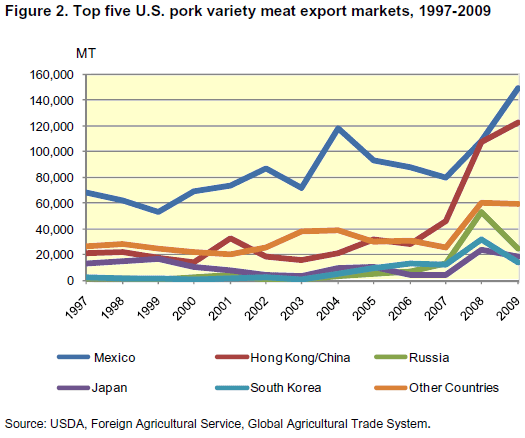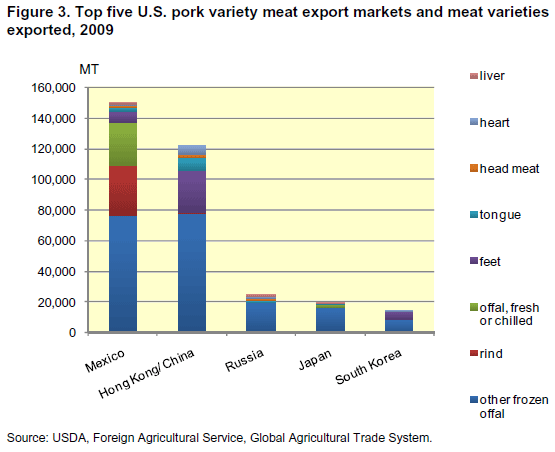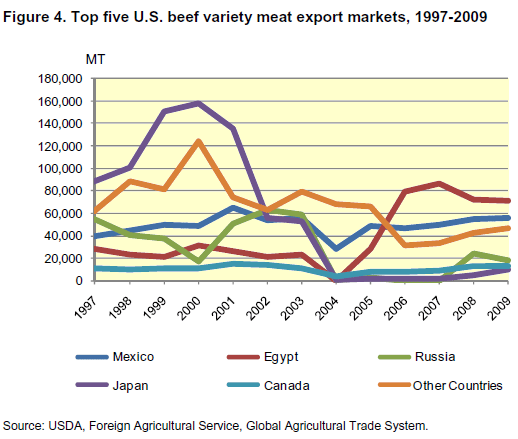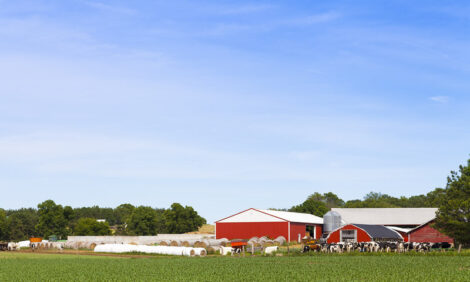



US Livestock and Dairy Outlook - September 2010
Demand, both foreign and domestic, continues to recover but price increases will be modest. Both cow numbers and production per cow are expected to rise, increasing milk production next year. Butter prices should moderate next year due to higher milk production, according to the latest Livestock, Dairy, and Poultry Outlook from the USDA's Economic Research Service.
Beef/Cattle: Steer and heifer and cow slaughter rates continue at or ahead of rates last year, but lower dressed weights have yielded lower beef production. Prices continue to show strength.
Beef/Cattle Trade: In 2010, exports of US beef are forecast to increase 17 per cent year-over-year, totaling 2.26 billion pounds. Beef exports through July were nearly 17 per cent higher year-over-year. Beef imports for 2010 are forecast at 2.54 billion pounds and with tighter beef supplies in 2011 are forecast to increase 8 per cent, to 2.75 billion pounds. Through July, beef imports were 12 per cent below year-earlier levels and cattle imports nearly 17 per cent higher year-over-year.
Special Article: “US Variety Meat Exports and the Global Marketplace”
Beef/Cattle
Higher Grain Prices Could Redistribute Slaughter
Current crop production estimates indicate crop yields lower than those estimated last month. To the extent feed grain supplies are tighter than previously expected, demands for feeder cattle will be affected by higher corn prices and livestock costs of grain. Partially offsetting the corn price increases, soybean meal prices are forecast lower than they were last month. In some feeding areas, anticipated increases in ethanol production due to ethanol production mandates and higher ethanol prices could also offset some of the increase in corn prices, to the extent that increased ethanol production results in greater supplies of coproducts and lower relative feed values.
Cow slaughter continues at an atypically high rate, given the cow herd base, and heifers continue to make up a larger share of cattle slaughter than they did last year. Both of these factors imply the potential for further declines in the national beef cow herd.
While expectations for grain crops are declining, pastures have clearly benefited from favorable growing conditions over most of the United States this past spring and summer. As a result, feeder cattle have remained on pastures until recently. These cattle could also be heavier than usual. If so, the larger numbers of heavier cattle available for fall placement in feedlots could contribute to conflicting dynamics operating in the market for feedlot-ready feeder cattle. The dynamics would be a shift from pulling feeder cattle forward to place in feedlots—at lighter weights—and the potential near-term abundance of heavier cattle available for feedlot placement.
Until now, it appeared that feeder cattle were being pulled forward and marketed early. Higher corn prices could slow or reverse the early placements of lighter feeder cattle in feedlots, which would likely spread marketings into the future. Placing fewer feeder cattle this fall would likely push marketings out of feedlots into future periods.
Fewer marketings next spring and summer could also mean reduced beef production for 2011, although this outcome would also depend on dressed-weight dynamics—heavier placement weights would likely result in heavier dressed weights and could affect beef production, despite potentially lower year-over-year slaughter. However, higher corn prices generally provide incentive for shorter rather than longer feeding periods. This relationship between corn prices and feeding periods underlies the logic of placing heavier off-grass feeder cattle when corn prices are relatively high. Despite the significant increase in second-quarter 2010 placements over 2009 and 2008 placements, the extended favorable grazing season may provide feedlot placements of relatively large numbers of heavy feeder cattle during August and September. With current hedging opportunities, these cattle could provide positive cattle feeding margins into next year, despite higher corn prices.
Labor Day marked the end of the summer grilling season and is typically followed by a decline in retail/wholesale beef prices. Prices will likely follow the same pattern this fall, but on the heels of the recent price spike, the declines may be moderated. Higher fed cattle prices associated with generally tighter supplies of market-ready fed cattle will be offset to some extent at the wholesale level by higher byproduct values and continued increases in foreign demand for beef and variety meats (see special article, “US Variety Meat Exports and the Global Marketplace.”). These offsets will allow packers to continue bidding relatively high prices for the tighter supplies of fed cattle. However, shorter beef supplies and higher prices for competing pork and poultry should provide some support for prices throughout the beef/cattle complex through at least the end of 2010.
Beef/Cattle Trade
Beef Export Levels Sustained into Fourth Quarter
US beef exports are forecast to increase 17 per cent in 2010, totaling 2.26 billion pounds. Beef exports by the United States through July were 17 per cent higher year-over-year. Increased shipments to Asian markets, namely Japan and South Korea, in addition to higher trade levels to several relatively smaller markets such as Russia and Egypt, have been key drivers in the US beef export market thus far in 2010. Through July, exports to South Korea and Japan increased 127 and 21 per cent, respectively, year-over-year. The Japanese yen has risen sharply in recent weeks against the US dollar and currently remains at its highest level since 1995. The weaker US dollar makes US products relatively cheaper and more attractively priced in Japan, particularly in light of the current strength of the Australian dollar, the primary US competitor for beef markets in Asia. The United States is expected to gain a greater share of the Japanese beef market in both the near and longer terms. Currently, the United States holds a 16-per cent share of the Japanese beef import market compared with Australia’s 73 per cent. In South Korea, total world beef exports increased 21 per cent through July, and the United States has captured substantially greater year-over-year gains in this market. The United States currently holds 30 per cent of the South Korean beef import market, second to Australia’s 52 per cent.
Continued demand from traditionally smaller markets has also boosted US beef exports in 2010, with four per cent and three per cent of US beef exports through July going to Russia and Egypt, respectively. Although periodically elevated, US beef exports to these markets have been historically negligible. Overall, strong global demand for beef continues to support the domestic market and underpin US wholesale beef prices. In 2011, 2.15 billion pounds of beef are forecast to be exported, while demand for US beef in Asian markets should continue strengthening. The 2011 beef export forecast remains a robust figure, considering tighter domestic supplies due to the smaller US calf crop and total cattle inventory registered for this year and forecast for next.
Canadian Slaughter Cattle Imports May Decline into 2011
There are still incentives for Canadian and Mexican cattle feeders and producers to export cattle to the United States due to higher US cattle prices. Canadian cattle feeders are capturing higher prices for fed cattle—which through the summer months have been readily available from Canada— and feeder cattle in US markets are priced more attractively to Mexican producers than they are in Mexico. Canadian and Mexican cattle imports through July were 6 and 31 per cent higher than year-earlier levels. However, steer and heifers imported from Canada for slaughter may decline by the end of the year as summer placements in Canada have been below year-earlier levels. June-August Canadian placements were also at the lowest levels seasonally since 2004; thus, Canadian marketings and, subsequently, the availability of exportable slaughter cattle to the United States, should decline by the end of this year. Currently, Canadian feeder cattle are trading at a premium to US values and Canadian cow-calf producers have abundant forage supplies, limiting export movement. The size of the increase in feeder cattle from Mexico this fall will also be largely dependent upon weather and forage conditions in Mexico.
US Variety Meat Exports and the Global Marketplace
Daniel L. Marti
Rachel J. Johnson
Variety meats may not make up the “heart” of the US meat industry, given that dishes such as beef tongue or pig heart do not typically grace American dinner tables. In fact, these and other variety meats are often considered to be inferior food in US markets. Nonetheless, variety meat from beef and pork slaughter is important to the bottom line of the US meat industry. This is evident in both the value that variety meat adds to the US meat industry and the volume of sales into the variety meat channel.
Animal byproducts are items produced as a result of animal slaughter and include portions of the entire animal that are not part of the dressed carcass. In the United States, animal byproducts fall into two categories: edible and inedible offal. Variety meats are a subcategory of edible offal consisting of the liver, heart, tongue, tail, kidney, brain, sweetbreads (thymus and/or pancreas gland, depending on animal’s age), tripe (stomach), chitlings and natural casings (intestines), fries (testicles), rinds, head meat, lips, fats and other trimmings, and blood (Ockerman and Hansen, 1998). Some edible offal is also used to make gelatin, sausage casings, and rennin used in cheesemaking. These products are all part of the US meat industry, but just how important are they?
The supply of edible offal produced in the United States is relatively large in comparison with its domestic demand. US demand for edible offal stems from consumption of products such as sausages and hot dogs and the use of variety meats in pet food. The remainder is available for shipment to foreign markets where they are more highly valued. While carcasses and high-value cuts comprise the majority of total red meat exports, edible offal exports have constituted about 22 per cent of the volume of total beef- and pork-product exports over the last 5 years. The United States has historically been the world’s largest exporter of beef and pork edible offal, accounting for more than 18 per cent of total world exports over the last 10 years (fig. 1). US pork edible offal exports were nearly 20 per cent of total pork exports in 2009, and over 24 per cent of total US beef exports last year were edible offal.

Variety meats in some countries are considered delicacies, while in other countries their consumption is associated with low incomes (Halstead, 1999). However, in many regions variety meats are the basis of traditional flavors. Demand for variety meats is especially strong in many Asian nations. In China, most recipes call for sharp-tasting variety meats, not muscle cuts, which are considered bland (Hayes, 1997); cow tongues are considered expensive delicacies in Japan; sliced beef feet are used for soup in South Korea; and stomachs, lungs, and livers are highly valued meats in Colombia (Bean, 1996). Tongue and liver are used in many Mexican dishes, such as putzaze (tripe and liver with tomatoes), lengua (tongue with green chilies), and menudo norteña (tripe soup). However, in Russia, one of the world’s largest offal importers, variety meats are connected to lower incomes and used as an inexpensive way to obtain protein and nutrition (Kamenski, 2006).
Pork Variety Meat Exports and Markets
Mexico is by far the largest importer of US pork variety meats, accounting for 46 per cent over the last decade (fig. 2). Other major destinations of US exports include Hong Kong/China, Russia, Japan, and South Korea. However, many of these markets have developed only in recent years. Since 2008, Hong Kong/China has begun to rival Mexico as the number one export market for US pork variety meats in terms of volume. In this study, Hong Kong and China are considered as one export destination because much of the US product is transshipped from Hong Kong to China (Bean, 1996). Until 2007, exports of all US variety meats to Hong Kong/China were marginal, but last year US exports of pork variety meat to Hong Kong/China jumped to almost 123, 000 MT, 32 per cent of all US pork variety meat exports.

Major US pork variety meat exports over the last 5 years include hog feet (14 per cent of US pork offal exports), fresh or chilled offal (11 per cent), rinds (10 per cent), and all other frozen offal (56 per cent) (fig. 3). In terms of the destinations for these products, Mexico imported over 94 per cent of all US-exported pork rinds and 76 per cent of US fresh or chilled pork offal exports, Russia was by far the largest purchaser of US hog liver exports in 2009, and Hong Kong/China also was the number one importer of US hog feet, pig tongues, and pig-heart exports last year.

Beef Variety Meat Exports and Markets
Historically, Japan has been the largest importer of US beef variety meats, buying over 21 per cent of US beef variety meat exports over the last decade. Other traditionally large importers include Mexico, Egypt, Russia, and Canada (fig. 4). While exports to the major US beef variety meat markets have been gradually increasing since 2003, beef variety meat exports to Egypt have risen sharply: in 2009, over 33 per cent of US beef variety meat exports went to Egypt, making it the largest destination for these exports. This increase was driven by the efforts of Egyptian entrepreneurs to put beef liver and other items in Egypt’s retail outlets and supermarkets, as well as on the menus of hotels and restaurants. Egyptians have developed a preference for beef livers from the United States over substitute markets such as Brazil’s, as grain-fed beef, predominant in the US, tends to result in a more flavorful product than grass-fed beef exports from other countries (Kamenski, 2006).
Traditionally, the United States’ top beef variety meat export has been liver (fig. 5). Over the last 5 years, bovine livers have encompassed 51 per cent of all US beef variety meat exports. Other important US variety meat exports over the last 5 years have included lips (7 per cent of US beef offal exports), hearts (7 per cent), tongues (6 per cent), kidneys (4 per cent), and all other frozen offal (23 per cent). A vast majority of all US beef lips, sweetbreads, brains, and tongue in 2009 went to Mexico, as well as most beef heart exports.


Looking Ahead
Protein intake is often dependent upon income, as are the types of proteins consumed. Increasing per capita incomes and rising GDP may have varied affects on consumption and trade of variety meats, depending on how the products are viewed in each country. In countries such as Egypt and Japan, where certain variety meats are more highly valued, increasing wealth and GDP growth may result in increased US variety meat exports. Egyptian demand should remain strong since the country has a younger population, a relatively high rate of economic growth compared with world growth, and a limited capacity to expand domestic production, factors likely to support growth in demand for beef products (Kamenski, 2006). As incomes rise in other countries, certain variety meats may begin to be viewed as inferior goods, which may cause US variety meat exports to decline in some segments of these markets. In portions of the Mexican, Russian, and Chinese markets, for example, variety meat consumption may give way to increasing consumption of muscle cuts as tastes and preferences change. However, preferences in other countries for certain culinary traditions (which are strongly tied to variety meat use) will continue to play an integral role in demand for US variety meat exports.
References:
Bean, R. “Beef tongues to pork maws, foreign markets hunger for variety meats.” AgExporter, June-July 1996. http://findarticles.com/p/articles/mi_m3723/is_n5_v8/ai_18752623/?tag=content;col1
Halstead, T. “US Variety Meat Exports on the Upswing.” FASonline, 1999. http://www.fas.usda.gov/dlp2/circular/1999/99-03LP/variety.htm
Hayes, Dermot. “Chinese Market for US Pork Exports.” Trade Research Center, Aug. 1997: 11. http://ageconsearch.umn.edu/bitstream/29173/1/pip02.pdf
Kamenski, C. “Variety meats vital to boosting US beef exports.” Issues Update, March-April 2006: 29-30. http://www.beefusa.org/uDocs/varietymeatsvitaltoexports.pdf
Ockerman H.W., and C.L. Hansen. 1998. Animal Byproduct Processing and Utilization, 1st ed. Lancaster, PA: Technomic.
Dairy
Only Moderate Price Increases Are Expected in 2011 as Milk Production Continues To Rise
Feed prices are forecast higher in 2010/11, with corn expected to average $4.00 to $4.80 per bushel and soybean meal to average $270 to $310 per ton. The milk-feed price ratio rose this year and is expected to average 2.3 for 2010; next year the index is expected to decline slightly from 2010 because of higher forecast feed prices. While this indicator of profitability has substantially improved from 2009’s depressed level, it remains low enough this year and next that some producers may face financial difficulties.
Despite a relatively weak milk-feed price ratio, cow numbers continue to rise yearover- year. The most recent Milk Production report indicated cow numbers higher in the second quarter of 2010 than in the first, although the herd was still smaller than in the corresponding quarter of 2009. USDA projects the number of cows in the US dairy herd to average 9,125 thousand head this year, increasing to 9,160 in 2011.
Production per cow has also advanced In 2010 and is projected to rise by nearly 2.6 per cent above 2009. A rise in production per cow is also forecast for 2011, but the rise is expected to be near trend at 1.5 per cent. The expected rise in herd size and increased per cow production translates into more milk. USDA projects milk production at 192.7 billion pounds this year, rising to 196.2 billion in 2011.
Milk production in Oceania for the upcoming season is expected to recover from last year. The prospect of more milk on the world market is expected to impact US exports next year. Milk equivalent exports on a fats basis are expected to total 6.6 billion pounds in 2010 but to slide to 5.4 billion next year, dampened by improved world production. Milk equivalent exports on a skims-solids basis are projected to be 29.3 billion pounds this year and to decline to 28.3 billion in 2011. Imports declined this year compared with 2009 on both a fats and skims-solids basis; imports are expected to total 4.1 billion pounds, fats basis, and 4.5 billion pounds, skims-solids basis. In 2011, imports will likely decline slightly to 4.0 billion pounds and 4.3 billion pounds, respectively. Recovering global and higher domestic milk production is the major reason.
Stocks are forecast to end this year below 2009 totals on a fats basis, reaching 10.4 billion pounds, largely due to lower expected butter stocks. This year’s skim ending stocks are forecast slightly higher at 11.5 billion pounds. Next year, ending stocks are expected to tighten to 10.4 billion pounds on a fats basis and to 11.2 billion pounds on a skims-solids basis. International and domestic demand for butterfat is expected to remain strong both this year and next. Domestic commercial use on a fats basis is expected to rise 2.2 per cent in 2011 after staging a 1.2 per cent increase this year compared with 2009. Commercial use on a skims basis is projected to decline about 1 per cent below 2009 but rebound in 2011, climbing 2.8 per cent from this year’s total.
Cheese prices have risen sharply this year due to increased demand. Although cheese stocks remain above the 5-year average, prices are expected to average $1.530 to $1.550 per pound in 2010. Next year, prices are expected to rise, but not as precipitously, to average $1.530 to $1.630 per pound. Butter prices started to climb in late 2009 and have soared this year. The strong demand for fats has moved milk to other uses and, consequently, butter production has lagged and prices have spiked. The decline in milk production in 2009 may have contributed to the tight supplies this year. Butter prices are expected to average $1.690 to $1.730 per pound in 2010. Next year, butter prices will remain high by historic standards, but should moderate from 2010’s highs. Butter prices are expected to average $1.485 to $1.615 per pound in 2011. Greater milk production in 2011 should help lower prices. Nonfat dry milk (NDM) prices tracked the price runup for butter, since the movement of milk to other products reduced NDM production. Export demand for NDM also contributed to the rising NDM prices in 2010. NDM is expected to average $1.150 to $1.170 per pound. Next year’s price increases are forecast to moderate to $1.175 to $1.245 per pound. Export demand should support the higher price, while increased milk production should limit increases.
The 2010 Class IV price, which is projected to average $14.90 to $15.20 per cwt, will likely be lower in 2011, based on lower butter prices. In 2011, the Class IV price is forecast to average $14.25 to $15.35 per cwt. The Class III price is forecast to remain about the same in 2011, as greater milk supplies counter continued high cheese prices. The average Class III price is estimated to be $14.50 to $14.70 per cwt this year and average $14.40 to $15.00 per cwt next year. The price outlook for products should hold the all milk price nearly even, averaging $16.25 to $16.45 per cwt this year and averaging $15.85 to $16.85 per cwt in 2011.
September 2010


